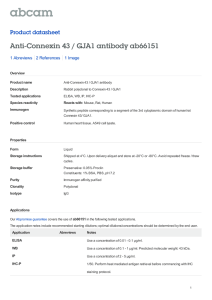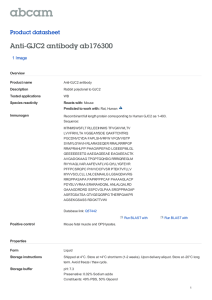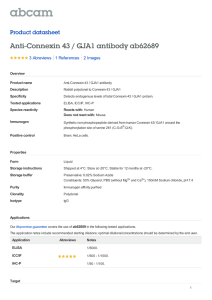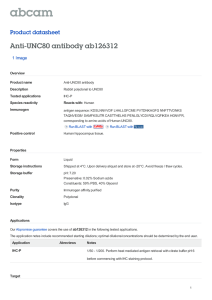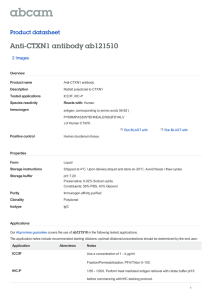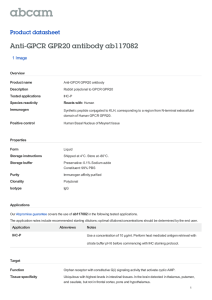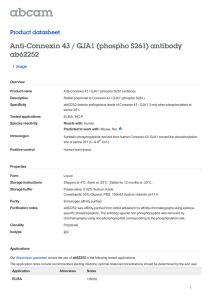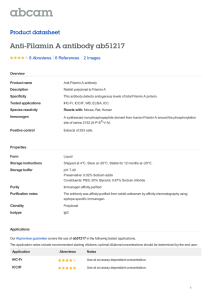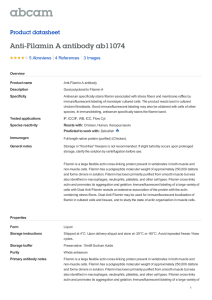Anti-Connexin 43 / GJA1 antibody ab117843 Product datasheet 3 Abreviews 4 Images
advertisement
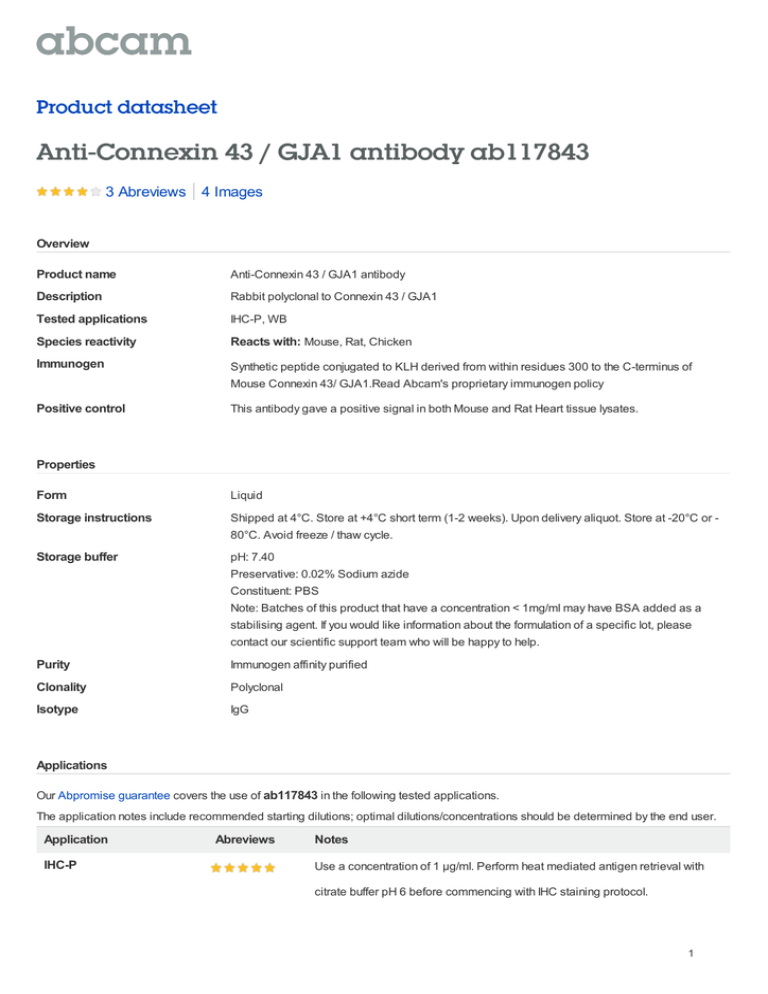
Product datasheet Anti-Connexin 43 / GJA1 antibody ab117843 3 Abreviews 4 Images Overview Product name Anti-Connexin 43 / GJA1 antibody Description Rabbit polyclonal to Connexin 43 / GJA1 Tested applications IHC-P, WB Species reactivity Reacts with: Mouse, Rat, Chicken Immunogen Synthetic peptide conjugated to KLH derived from within residues 300 to the C-terminus of Mouse Connexin 43/ GJA1.Read Abcam's proprietary immunogen policy Positive control This antibody gave a positive signal in both Mouse and Rat Heart tissue lysates. Properties Form Liquid Storage instructions Shipped at 4°C. Store at +4°C short term (1-2 weeks). Upon delivery aliquot. Store at -20°C or 80°C. Avoid freeze / thaw cycle. Storage buffer pH: 7.40 Preservative: 0.02% Sodium azide Constituent: PBS Note: Batches of this product that have a concentration < 1mg/ml may have BSA added as a stabilising agent. If you would like information about the formulation of a specific lot, please contact our scientific support team who will be happy to help. Purity Immunogen affinity purified Clonality Polyclonal Isotype IgG Applications Our Abpromise guarantee covers the use of ab117843 in the following tested applications. The application notes include recommended starting dilutions; optimal dilutions/concentrations should be determined by the end user. Application IHC-P Abreviews Notes Use a concentration of 1 µg/ml. Perform heat mediated antigen retrieval with citrate buffer pH 6 before commencing with IHC staining protocol. 1 Application Abreviews WB Notes Use a concentration of 1 µg/ml. Detects a band of approximately 43 kDa (predicted molecular weight: 43 kDa). Target Function One gap junction consists of a cluster of closely packed pairs of transmembrane channels, the connexons, through which materials of low MW diffuse from one cell to a neighboring cell. May play a critical role in the physiology of hearing by participating in the recycling of potassium to the cochlear endolymph. Tissue specificity Expressed in the heart and fetal cochlea. Involvement in disease Defects in GJA1 are the cause of autosomal dominant oculodentodigital dysplasia (ODDD) [MIM:164200]; also known as oculodentoosseous dysplasia. ODDD is a highly penetrant syndrome presenting with craniofacial (ocular, nasal, dental) and limb dysmorphisms, spastic paraplegia, and neurodegeneration. Craniofacial anomalies tipically include a thin nose with hypoplastic alae nasi, small anteverted nares, prominent columnella, and microcephaly. Brittle nails and hair abnormalities of hypotrichosis and slow growth are present. Ocular defects include microphthalmia, microcornea, cataracts, glaucoma, and optic atrophy. Syndactyly type 3 and conductive deafness can occur in some cases. Cardiac abnormalities are observed in rare instances. Defects in GJA1 are the cause of autosomal recessive oculodentodigital dysplasia (ODDD autosomal recessive) [MIM:257850]. Defects in GJA1 may be the cause of syndactyly type 3 (SDTY3) [MIM:186100]. Syndactyly is an autosomal dominant trait and is the most common congenital anomaly of the hand or foot. It is marked by persistence of the webbing between adjacent digits, so they are more or less completely attached. In this type there is usually complete and bilateral syndactyly between the fourth and fifth fingers. Usually it is soft tissue syndactyly but occasionally the distal phalanges are fused. The fifth finger is short with absent or rudimentary middle phalanx. The feet are not affected. Defects in GJA1 are a cause of hypoplastic left heart syndrome (HLHS) [MIM:241550]. HLHS refers to the abnormal development of the left-sided cardiac structures, resulting in obstruction to blood flow from the left ventricular outflow tract. In addition, the syndrome includes underdevelopment of the left ventricle, aorta, and aortic arch, as well as mitral atresia or stenosis. Defects in GJA1 are a cause of Hallermann-Streiff syndrome (HSS) [MIM:234100]. HSS is a disorder characterized by a typical skull shape (brachycephaly with frontal bossing), hypotrichosis, microphthalmia, cataracts, beaked nose, micrognathia, skin atrophy, dental anomalies and proportionate short stature. Mental retardation is present in a minority of cases. Sequence similarities Belongs to the connexin family. Alpha-type (group II) subfamily. Cellular localization Cell membrane. Cell junction > gap junction. Anti-Connexin 43 / GJA1 antibody images 2 Immunohistochemical analysis of PFA-fixed paraffin-embedded rat cardiac tissue sections, labelling Conexin 43 with ab117843 at a dilution of 1/500 incubated for 12 hours at 4°C in 1% BSA in TBS. Antigen retrival was via Tris-EDTA pH 9.0 (heat mediated). Blocking was 3% BSA incubated for 1 hour at 37°C. The secondary was ab6721 at 1/500. Immunohistochemistry (Formalin/PFA-fixed paraffin-embedded sections) - Anti-Connexin 43 / GJA1 antibody (ab117843) Image is courtesy of an Abreview submitted by Dr Helder Fonseca. IHC image of Connexin 43 / GJA1 staining in Mouse normal heart formalin fixed paraffin embedded tissue section, performed on a Leica BondTM system using the standard protocol B. The section was pre-treated using heat mediated antigen retrieval with sodium citrate buffer (pH6, epitope retrieval solution 1) for 20 mins. The section was then incubated with ab117843, 1µg/ml, for 15 mins Immunohistochemistry (Formalin/PFA-fixed at room temperature. A Goat anti-Rabbit paraffin-embedded sections) - Anti-Connexin 43 / biotinylated secondary antibody was used to GJA1 antibody (ab117843) detect the primary, and visualized using an HRP conjugated ABC system. DAB was used as the chromogen. The section was then counterstained with haematoxylin and mounted with DPX. For other IHC staining systems (automated and non-automated) customers should optimize variable parameters such as antigen retrieval conditions, primary antibody concentration and antibody incubation times. 3 All lanes : Anti-Connexin 43 / GJA1 antibody (ab117843) at 1 µg/ml Lane 1 : Heart (Mouse) Tissue Lysate Lane 2 : Heart (Rat) Tissue Lysate Lysates/proteins at 10 µg per lane. Secondary Goat Anti-Rabbit IgG H&L (HRP) preadsorbed (ab97080) at 1/5000 dilution Western blot - Anti-Connexin 43 / GJA1 antibody developed using the ECL technique (ab117843) Performed under reducing conditions. Predicted band size : 43 kDa Exposure time : 1 minute IHC-Fr image of anti-Connexin 43/GJA1 staining with ab117843 on tissue sections from chicken hindbrain. The sections were blocked with 3% BSA for 1 hour at 4°C, before incubation with ab117843 (1/1000 dilution) for 16 hours at 4°C. The secondary was an Alexa-Fluor 488 conjugated goat antirabbit polyclonal, used at a 1/1000 dilution. Immunohistochemistry (Frozen sections) - AntiConnexin 43 / GJA1 antibody (ab117843) This image is courtesy of an anonymous abreview. Please note: All products are "FOR RESEARCH USE ONLY AND ARE NOT INTENDED FOR DIAGNOSTIC OR THERAPEUTIC USE" Our Abpromise to you: Quality guaranteed and expert technical support Replacement or refund for products not performing as stated on the datasheet Valid for 12 months from date of delivery Response to your inquiry within 24 hours We provide support in Chinese, English, French, German, Japanese and Spanish Extensive multi-media technical resources to help you We investigate all quality concerns to ensure our products perform to the highest standards If the product does not perform as described on this datasheet, we will offer a refund or replacement. For full details of the Abpromise, please visit http://www.abcam.com/abpromise or contact our technical team. 4 Terms and conditions Guarantee only valid for products bought direct from Abcam or one of our authorized distributors 5
